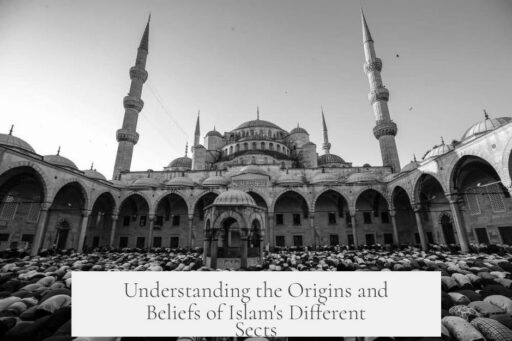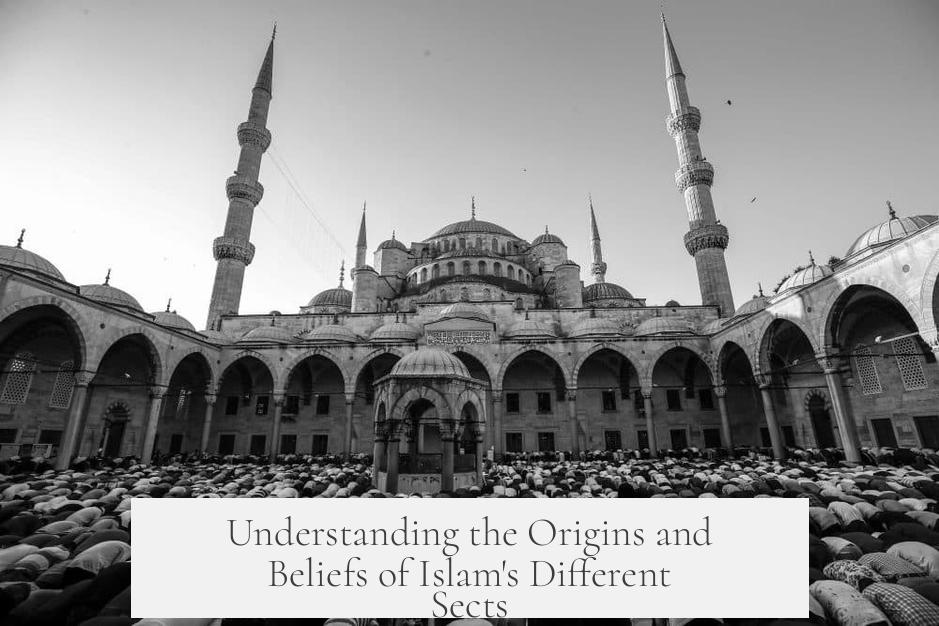The main sects of Islam, Sunni and Shi’a, originated due to a dispute over who should lead the Muslim community (umma) after Prophet Muhammad’s death in 632 CE. Sunnis support the idea of electing the leader, the Caliph, through consensus or shura, beginning with Abu Bakr. Shi’as believe leadership should stay within Muhammad’s family, specifically appointing Ali, his cousin and son-in-law, and his descendants as divinely chosen Imams.

This division began shortly after the Prophet passed away, with political motivations defining the initial split. The first Caliph, Abu Bakr, was chosen by a council to maintain unity among diverging tribes. However, a faction called Shi’at Ali insisted that Ali be the rightful leader based on bloodline. This resulted in a mostly political disagreement rather than a theological break at first.
Ali eventually became the fourth Caliph, but his reign was marred by internal conflict and challenges from rival factions. His assassination by a former follower marked a critical turning point, followed by a civil war between forces loyal to Ali’s family (Shi’a) and followers of Muawiyah, a Syrian governor backed by the Sunni majority. The decisive battle at Karbala, where Ali’s son Hussein was killed, deeply affected Shi’a religious identity and is commemorated annually on Ashura through mourning rituals like self-flagellation. Sunnis do not observe these practices.

The assassination of the third Caliph, Uthman, triggered unrest that contributed to the conflict between Ali and Muawiyah. Muawiyah did not accept Ali as Caliph initially, leading to the Kharijites—a radical sect rejecting all human rulers—who assassinated Ali. After Ali’s death, Hassan, Ali’s son, made a peace agreement with Muawiyah, ceding power under terms favoring Muawiyah’s hereditary succession. Hassan’s subsequent poisoning and Muawiyah’s appointment of his son Yazid intensified the tensions resulting in Hussein’s revolt and martyrdom at Karbala.
Sunni Islam bases leadership on the principle of community consensus. The Caliph is chosen (or was chosen historically) through a form of election or agreement among Muslim leaders. Sunni jurisprudence, or fiqh, developed mainly around the teachings of early scholars like Abu Hanifa. Sunni traditions emphasize order and historical continuity in leadership and law.

Shi’a Islam holds that leadership is divinely ordained, limited to the Prophet’s progeny through Ali and Fatimah. The Imams are considered not only political leaders but also spiritual guides with special authority. Shi’a jurisprudence has developed distinct legal schools and doctrinal interpretations. Their rituals differ slightly, permitting some forms of representation in art and emphasizing mourning ceremonies connected to Karbala.
Despite their differences, both Sunni and Shi’a Muslims share core beliefs. Both affirm the oneness of God (tawhid), the prophethood of Muhammad, the sacredness of the Qur’an, and the Five Pillars of Islam (faith, prayer, almsgiving, fasting, pilgrimage). The schism’s origin is political rather than strictly theological, with ritual differences evolving from early political conflicts.

Aside from these, early Islamic history saw other sects like the Kharijites, who opposed all rulers claiming authority except God alone. They are remembered for their extremist positions and political violence, including assassinations against Ali and Muawiyah.
Another group, the Ibadi, today mainly found in Oman, traces its roots to early Islamic movements but remains distinct from both Sunni and Shi’a. Though not detailed here, they represent a moderate and historically significant sect.

The early Islamic caliphates illustrate this rivalry. The Rashidun Caliphate (632–661) included the first four leaders, all companions of Muhammad. Afterward, the Umayyad (661–750) and Abbasid Caliphates (750–1258) established hereditary dynasties, moving away from the initial electoral ideal. Although powerful, these dynasties sometimes faced accusations of deviating from true Islamic leadership principles.
Throughout history, Sunni and Shi’a communities have experienced periods of repression and violence against each other. The Fatimid Caliphate (a Shi’a dynasty in Egypt) allied with militant groups known as the Assassins, notorious for targeting Sunni leaders and crusaders, exemplifying sectarian strife. Both sects have seen rulers who oppressed rival groups as part of political consolidation.

| Sect | Origin | Leadership | Key Beliefs | Distinct Practices |
|---|---|---|---|---|
| Sunni | Election of Abu Bakr after Muhammad’s death (632 CE) | Caliph chosen by community consensus (shura) | Follow Qur’an, Hadith; respect first four CaliphsLegal schools: Hanafi, Maliki, Shafi’i, Hanbali | Strict avoidance of depicting humans/animalsNo Ashura self-flagellation |
| Shi’a | Support for Ali, Prophet’s relative; leadership hereditary | Imams are divinely appointed descendants of Ali | Emphasis on Imamate as spiritual/political authorityDifferent legal interpretations | Ashura mourning rituals with self-flagellationPermissive about some religious art |
| Kharijites | Rebellion against Ali and Muawiyah leadership | No human ruler except God alone | Extremist purity; reject all corrupt rulers | Assassinations of Caliphs |
| Ibadi | Early Islamic sect branching from Kharijites | Moderate leadership model; distinct community | Combines Sunni and Shia elements | Focus on tolerance and community consensus |
- The Sunni-Shi’a split originated as a political dispute over succession after Muhammad.
- Ali’s leadership and his son Hussein’s martyrdom at Karbala are central to Shi’a identity.
- Sunni leadership is elected; Shi’a leadership is hereditary and divinely appointed.
- Ritual practices differ but core Islamic beliefs remain shared.
- Historical sectarian conflicts have shaped Muslim political and religious landscapes.
Understanding the Different Sects of Islam: Origins, Beliefs, and History Explained
The split between the different sects of Islam, primarily Sunni and Shi’a, began almost immediately after the Prophet Muhammad’s death due to a fundamental disagreement about leadership succession. Sunni Muslims believe the leader, called the Caliph, should be elected by the community, while Shi’a Muslims hold that leadership was divinely appointed to the Prophet’s family, specifically his cousin and son-in-law, Ali. This simple disagreement evolved into complex political, social, and religious differences that still influence the Islamic world today.

So, what exactly triggered this major split? And what sets these groups apart in beliefs and practice? Buckle up, as we dive into the riveting story behind the sects of Islam.
The Succession Puzzle: Selecting the First Caliph
When Prophet Muhammad passed away without naming an heir, the Muslim community (or umma) faced a big question: who leads next? Here’s where history takes a twist.
The Muslim tribes gathered in a sort of “National Convention,” known as the shura, to choose the next leader. This democratic process led to Abu Bakr becoming the first Caliph. However, not everyone thought this was the right way. Some believed leadership should stay within the Prophet’s family. Enter the faction called Shi’at Ali—the party of Ali.
In essence, our Sunni friends backed the shura election model, while the Shi’a stood by hereditary divine appointment. Political disagreements started here… but without the fireworks—yet.
The Political Origins Turn Fierce
Ali did eventually become the 4th Caliph, but his rule was anything but smooth sailing. Political infighting and palace intrigue dominated his tenure. Tragically, Ali was assassinated during prayer by a former supporter linked to the radical Kharijite faction.
After Ali’s death, tensions boiled over. The civil war between those who sided with Ali’s son, Hussein (Shi’a), and supporters of Muawiyah (Sunni) culminated in the infamous Battle of Karbala. Hussein and his family were massacred—a moment so critical that Shi’a Muslims commemorate it annually with Ashura, featuring self-flagellation rituals to express deep mourning.
More Than Just Politics: The Kharijites and Other Early Sects
While Sunni and Shi’a dominated the Muslim landscape, other groups also emerged early on. The Kharijites, for instance, were fanatics who rejected all rulers, insisting that only God should rule mankind. They gained a notorious reputation by assassinating Ali and attempting the same with other leaders. But they faded over time.
And then there’s the Ibadi sect, lesser-known today, originating from early Islamic schisms and still present mainly in Oman. They maintain a more moderate stance, often viewed as a middle ground between Sunni and Shi’a.
Belief Differences: What Sets Sunni and Shi’a Apart?
At the heart of Sunni-Shi’a differences is leadership, but other threads run deep too.
- Leadership and Authority: Sunnis champion elected caliphs, while Shi’as hold fast to the idea that Imams from Ali’s lineage are divinely appointed leaders.
- Jurisprudence: Sunni law mainly derives from Abu Hanifa and other scholars, whereas Shi’a follow a distinct legal tradition that developed separately.
- Rituals and Culture: Shi’a openly mourn Hussein’s death with intense rituals during Ashura. Sunnis recognize Ashura too, but on a much quieter level, neither indulging in nor endorsing self-flagellation. Additionally, Sunni Islam generally forbids human or animal depictions in art; Shi’a are a bit more flexible, as long as sacred figures aren’t portrayed.
Despite these differences, both sects share foundational beliefs: the Quran as the word of God, following the Sunnah (the Prophet’s practices), adherence to the Five Pillars of Islam, and the core declaration that there is no God but God, and Muhammad is his messenger.
Power Plays, Dynasties, and Conflict
The story doesn’t end at Karbala. The rise of the Umayyad and Abbasid dynasties marked the move toward hereditary caliphates—something many argue were less about pure Islam and more about politics dressed in religious robes.
Muawiyah, for example, established the Umayyad dynasty, making his son Yazid the heir—a move that Shi’as see as a betrayal of the original principles of leadership. This hereditary leadership contrasted sharply with Sunni views. Both dynasties, while influential, have been critiqued by various scholars for their political motives rather than purely religious ones.
Inter-Sectarian Repression and Rivalries
History has been rough between these groups. Sunni rulers sometimes repressed Shi’a populations, and Shi’a regimes have done the same to Sunni communities when in power. This back-and-forth power struggle left scars that still echo through modern politics and religious tensions.
The Fatimid Caliphate, a Shi’a dynasty in Egypt, famously allied with a zealous sect called the Assassins. These Assassins were notorious for their political murders targeting Sunni elites, Crusaders, and even disobedient Shi’a leaders. An intriguing but grim chapter in Islamic history.
Why Does All This Matter Today?
The Sunni-Shi’a split isn’t just an academic topic or dusty history. It remains relevant, underpinning many political realities in the Middle East and beyond. Nations like Iran, Saudi Arabia, Iraq, and Lebanon feel the ripple effects of centuries-old sectarian divisions.
Understanding these roots helps make sense of current conflicts and fosters empathy. It is a reminder that many religious divides began politically and that ritual differences came later. This historical context offers hope: deeper knowledge can open doors to dialogue and unity.
Can There Be Sunni-Shi’a Unity?
Good question. Given shared core beliefs and scripture, unity is theoretically possible. However, centuries of political conflict, rivalry, and traditions make it challenging.
In recent years, some Islamic scholars and leaders promote inter-sectarian harmony by emphasizing common ground rather than differences. These peacebuilders highlight that the original split was more about leadership choices than faith fundamentals.
Final Thoughts: Islam’s Sects – More Nuanced Than Most Think
Islam’s divisions are a mix of history, politics, and theology. The initial question—who should lead after the Prophet?—sparked the great Sunni-Shi’a divide. Over time, distinct rituals, jurisprudence, and political practices emerged, but the underlying shared faith remains substantial.
So, next time someone asks about Islamic sects, you can confidently explain the succession struggle, key battles, political plays, and ritual differences. And you’ll know they all orbit around one central question: “Who has the right to lead the Muslim community?”
Feeling enlightened? Here’s a quick recap:
- Sunni Islam: Support elected leadership, follow four rightly guided Caliphs first, emphasize community consensus.
- Shi’a Islam: Believe leadership is divine, descended from Ali’s bloodline with Imams as spiritual guides, commemorate Karbala fiercely.
- Other Sects: Kharijites opposed all rulers, were militant; Ibadis are moderate and less known.
- Political Origins: The split was political first, theological differences developed over time.
- Shared Faith: Both embrace core Islamic tenets, the Quran, and Prophet Muhammad’s teachings.
That’s your crash course on Islam’s major sects. Complex, historical, and human—just like history itself.




